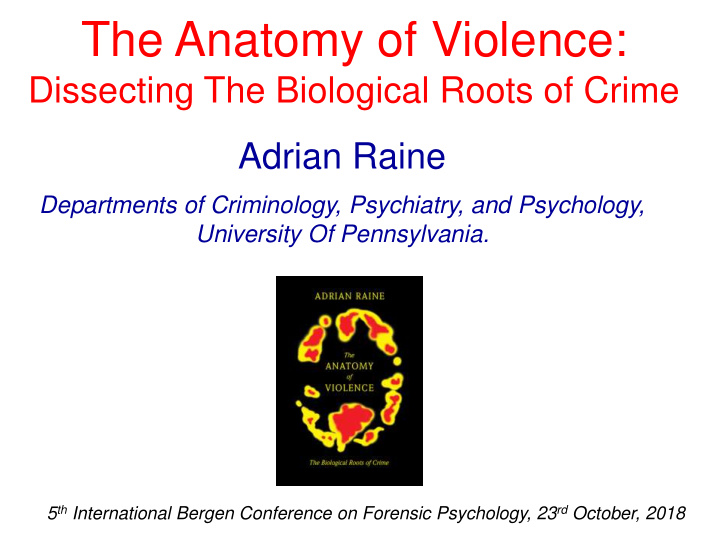



The Anatomy of Violence: Dissecting The Biological Roots of Crime Adrian Raine Departments of Criminology, Psychiatry, and Psychology, University Of Pennsylvania. 5 th International Bergen Conference on Forensic Psychology, 23 rd October, 2018
OUTLINE 1. Early Biological Risk Factors 2. Brain Mechanisms 3. Legal and Societal Implications prediction prevention punishment
Prenatal Nutrition and Adult Antisocial Personality
Brennan et al. (1999) • 4,169 males born 1959-1960 in Copenhagen % violent age 34 18 16 14 12 10 8 6 controlled for : 4 • SES, 2 • mum’s age 0 • mum’ education 0 1-2 3-10 10-20 >20 • unwanted pregnancy # cigarettes smoked 3 rd trimester • obstetric factors > 20 other studies find same relationship
FETAL ALCOHOL SYNDROME (FAS) Streissguth et al. (1996): 473 with FAS or FAE • 61% rate of delinquency • 58% police contacts in adulthood • 54% males (33% females) arrested / convicted after age 12
Jamillah Falls, Memphis, TN Baby girl born July 5, 2014 Baby tested positive for heroin & marijuana Convicted of assault - 6 months in prison PARENTAL RESPONSIBILTY OR … HELP, NOT HANDCUFFS
OUTLINE 1. Early Biological Risk Factors 2. Brain Mechanisms 3. Legal and Societal Implications
Prefrontal Dysfunction in Murderers Raine et al., 1994, Biological Psychiatry, 42 , 495-508 41 controls 41 murderers MURDERER NORMAL REACTIVE PROACTIVE NORMAL MURDERER MURDERER CONTROL
Amygdala and Psychopathy Yang et al., (2009). Archives of General Psychiatry 27 psychopaths vs. 32 non-psychopaths
Fear Conditioning at Age 3 and Crime at age 23 Gao et al. (2010) Am. J. Psychiat., 167, 156-160. Fear Criminals Controls Conditioning N = 1,795 3-year-olds 0.025 • fear conditioning at age 3 0.02 0.015 • criminal convictions at age 23 0.01 Criminal offenders N = 137 0.005 Matched controls N = 274 0 Match on: -0.005 sex, ethnicity, social adversity d = .35, p < .005 -0.01
Editorial: Philipp Sterzer (2010), American Journal of Psychiatry , 167, 1-3. “If not handled with great caution, neurobiological markers can easily be misused to stigmatize individuals who are perceived as a potential threat to society.” “Neurobiological research offers a great chance to further our understanding of antisocial and criminal behavior. This understanding should be used to benefit those children who are at greatest risk for a criminal career and to design interventions that are tailored to their needs”.
Amygdala, Moral Decision-Making & Psychopaths Glenn et al. 2009, Molecular Psychiatry,14 , 5 – 9 Amygdala Activation r = -.49 p < .05 Psychopathy Score
Psychopaths may know right from wrong, but … Do they having the feeling of what’s right and wrong?
OUTLINE 1. Early Biological Risk Factors 2. Brain Mechanisms 3. Legal and Societal Implications prediction prevention punishment
Amygdala Volume Predicts Later Violence Pardini et al. (2013) Biological Psychiatry Controlling for prior aggression, violence, and psychopathy
OUTLINE 1. Early Biological Risk Factors 2. Brain Mechanisms 3. Legal and Societal Implications prediction prevention
Raine et al. (2015). J. Child. Psychol. Psychiat. 56 509-520 Child Antisocial Behavior 9 Omega-3 Controls 8,5 8 7,5 7 p < .025 6,5 d = .38 6 5,5 5 4,5 4 0 Months 6 Months 12 Months Group x Time, p = .0001
Transcranial Direct Current Stimulation (tDCS) and Criminal Intent Choy et al. (2018), Journal of Neuroscience ) Double-blind, stratified, randomized controlled trial 39 tDCS stimulation 42 sham stimulation tDCS Controls tDCS Controls 25 69.8% reduction 47.5% reduction 10 20 8 % intention % intention 15 to commit 6 to commit crime crime 10 4 5 2 0 0 tDCS sham tDCS sham Physical assault Sexual assault
Mediation: Perceptions of Moral Wrongfulness Enhanced 1.60* -.32** Moral Wrongfulness Total effect = -1.64* Prefrontal Reduced tDCS Aggressive Intent Direct effect = -1.13 Indirect effect = -.51* * p <.05; ** p < .01 Enhanced perception of moral wrongfulness accounts for 31% of the total tDCS treatment group effect in reducing aggressive intent Stimulation of the Prefrontal Cortex Reduces Intentions to Commit Aggression: A Randomized Clinical Trial
OUTLINE 1. Early Biological Risk Factors 2. Brain Mechanisms 3. Legal and Societal Implications prediction prevention punishment
Neuroethics, Neurolaw, and Neurocriminology Interface If neurobiological impairments predisposes to antisocial behavior, are criminals responsible?
THE CASE OF MICHAEL: ACQUIRED PEDOPHILIA Burns & Swerdlow (2003) Arch. Neurol. 60 :437-440 40 years old, 2 nd marriage (stable), schoolteacher Michael no psychiatric history or sexually deviant behavior
Is Michael Responsible? Michael is responsible: he has rational capacity: 1. he knew what he was doing 2. he knew act was illegal / immoral “The fact is, I did what I did do. I am responsible for it, I am the one to blame.” Is it just to blame Michael? “Now, whether I should be held as accountable for it as someone without a tumor? No, I don’t think so”. Should we consider emotion alongside cognition in responsibility criteria? What about others with equivalent brain dysfunction which is not treatable, but present?
SUMMARY 1. Early Biological Risk Factors Early constraints on free will 2. Brain Mechanisms Prefrontal cortex, amygdala 3. Legal and Societal Implications Can omega-3 and prefrontal upregulation reduce crime? Better prediction from neurobiology? Should mercy season justice?
2018, 14, 259-28 9
Recommend
More recommend